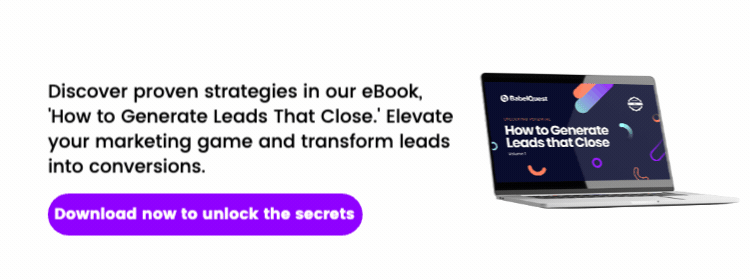Inbound marketing and lead nurturing go hand in hand. How could you better nurture your leads as part of your marketing strategy to turn today's visitors into tomorrow's customers?
With so many prospects sitting in your pipeline, it might surprise you to learn that 73% of your qualified leads aren't ready to close yet. The key to turning these prospects into tomorrow's customers is to stay on their radar until the time is right for them to take the next step with you and your organisation.
With almost limitless information at their fingertips and a blinkered approach when it comes to an obvious sales pitch, today the buyer has the power. To successfully match this change in behaviour and improve sales performance, you need to build long-lasting, meaningful relationships with your prospects.
How can you do this effectively without putting them off before that all important decision stage? Enter inbound marketing lead nurturing.

The two main reasons you may want to nurture a prospect:
- They could have signed up to your blog, or downloaded a guide because they find your website to be a useful source of information, but aren’t ready to hit 'go' yet.
- They may have downloaded a pricing list and spoken to one of the sales team but have decided to try solving their problem themselves first. You need to respect that and be on hand to offer advice if (or when) they find the DIY approach too difficult.
I’ve written before about the importance of being buyer-focused at all stages of the buyer’s journey and appreciate that a prospect is likely to move back and forth through the stages as part of their thought process. You need to be visible throughout that journey.
Discover how to implement a customer-centric strategy for B2B success.
Inbound marketing lead nurturing establishes trust
I’m a firm believer that trust plays a huge part in every transaction we make. If you build up a relationship, you make yourself more likely to be the go-to business at the end of the day. This idea is central to inbound marketing strategies.
Your prospects need to trust that you know what you’re talking about. Sitting back and hoping for the sales to roll in without any effort, especially when the prospect is going through two-thirds of the decision making process without you, is a losing game.
Let’s look at how to set up and implement successful lead nurturing strategies.
Effective lead nurturing strategies segment contacts
You can never hope to talk to everyone at once and say the right thing. Segmentation is the best way to make sure that you’re treating different parts of your database in different ways.
There are many ways to segment, from personas (a business owner will have different priorities and needs to an administrator) to individual industry sectors. Take a look at your list and consider the most sensible way to split it up and tailor your messages effectively.
Always keep the buyer’s journey in mind. Once you’ve segmented, make sure you’re also looking at their actions on the site to figure out what stage they’re at. It’s a great idea to have workflow automation in place to send out emails, tailored to what they’ve downloaded.
That way you know you’re being relevant and can also guide them towards the next step.

Segmentation doesn't have to take up all of your time. Consider creating a workflow that automatically enrolls prospects when they download a specific guide and sends them an email a few days later asking if they have any questions. You've put in the effort to get them to convert, so don't let that drop off straight after.
As well as asking if they have any questions, you could also highlight an article that relates to the topic. Line up a few well-spaced emails after this, which show a few more relevant articles gently encouraging them to subscribe and you have a nurture sequence that's relevant, tailored, and goal orientated around that subscription.
Don’t just rely on the website to kick start those nurture sequences. If the sales team are speaking to people who aren’t quite ready, get them to put the prospect into a workflow for the area they’re interested in.
You're having a conversation. Be human!
Remember that the point of your lead nurturing efforts is to create relationships with your prospects and help them to feel a connection to your business. Sending standardised, obviously automated emails really won’t help.
A lead nurturing strategy for making your marketing emails more human:
- Use personalisation tokens to insert their first name and anything else that is relevant to the email (if it makes sense to mention their business name and it’s included in your forms, do!)
- Write as you would talk to a prospect in real life. Just because it’s an email doesn’t mean it has to be an overly contrived essay
- Ask questions and share recent conversations so that you aren’t just pitching them an idea
- Never send a marketing email that you would hate to receive
- Consider the layout of your emails. Do they look like marketing communications or would you be better using a plain text format to enhance that personal touch?

Inbound marketing lead nurturing best practices
Have a purpose and clearly defined goal for each email and each sequence as a whole. If you’re taking the time to start a conversation through your emails, and personalise them, don’t fall at the last hurdle by messaging them for the sake of it.
Define what it is you want the receiver to do after they read this email or when they reach the end of the sequence. If your end goal is to get them to subscribe to your blog, take time to show them why it’s beneficial to them. If you are looking for engagement and responses, provoke an interesting train of thought.
Figure out how long the gap needs to be between emails (trial and error is your best friend here) and make sure you’re using suppression lists to avoid them being enrolled in multiple workflows at once.
If they simply aren’t engaging, send a break up email for one last try, and leave them alone. If they want to come back in future they will, but for now you know you tried.
Remember to think outside the (in)box
Creating relationships with prospects needs to be an all round effort, not just a single email sequence. Reflect the messaging that is on your website, and now that you’ve segmented your database, use smart content on your site.
Use the information you know about them to highlight relevant CTAs and wording specific to their industry or persona.
Keep your presence going outside of their inbox and your website with consistent content on social media, showing that you aren’t a company just interested in X amount of leads from a specific campaign, in a set timeframe.
The importance of lead nurturing in digital marketing
Already have an inbound marketing lead nurturing strategy? Great! Remember to review your progress and iterate. Don't put off performance analysis. If something isn’t working, it's most likely costing you time and money. There's a reason and you need to find out why.
If you don’t already have a strategy for lead nurturing and you're in the B2B space, you really can’t afford not to. Forming those connections needs to be a big part of business and will not only enable you to generate more leads that close from inbound, but will help you win those prized referrals that drive your business growth.
Learn more about lead nurturing and how it fits into your wider inbound strategy to generate revenue growth by downloading our free, 80-page marketing ebook below.







